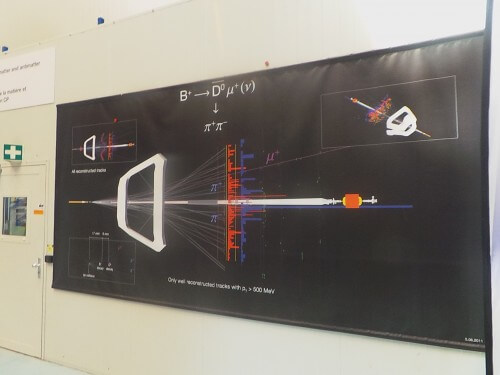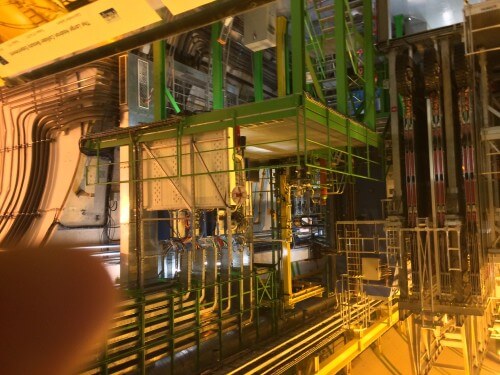In a study published at a scientific conference in New York, anomalies were revealed in the relationship between muons and electrons, which may indicate an unknown force or particle. However, the discoverers suggest conducting additional experiments to confirm the find, which they say is a flaw in the standard model.

At the LHC physics conference taking place in New York, members of the LHCb partnership presented findings that could hint at new physics.
LHCb, one of the four major experiments at the Large Hadron Collider is operated by scientists from over 50 institutes around the world. Researchers examine the properties of certain particles to look for deviations from the Standard Model of particle physics.
The Standard Model predicts that electrons from muons and tau particles, all members of the lepton family, should behave the same way and be produced in similar quantities in the decay of heavy particles.
"The standard model does not distinguish between muons and electrons in these decays," says Thom Blake, a Royal Society fellow who worked on the analysis of the findings. As far as our equations show, they are actually the same particle, so we should see them forming in almost equal amounts."
In their announcement, the LHCb team revealed that they had discovered hints of particles that contradict this prediction of the Standard Model. This could have been caused by undiscovered particles or forces.
LHCb scientists have discovered variation in the decay of particles containing b quarks. These particles decay into light hadrons immediately after they are created. However, in rare cases, they create two phones and one heron instead.
According to the standard model, this type of decay would have created an equal number of electrons and muons, but they found that in a quarter of the cases, more electrons were created. If the data collected in the next run of the particle accelerator at CERN continue to support this result, it could be a sign of new physics beyond the Standard Model.

"If we continue to see this contradiction, this may indicate a new particle - a heavy cousin of the Z boson that interferes with the production of the muon" says Michel de Kean, a postdoctoral fellow at the University of Heidelberg who presented the data.
Earlier, experts from the Bell Partnership in Japan and the BaBar Partnership at the American National Accelerator (SLAC) published measurements of the ratio of muons to electrons created during the decay. Both Bell and Bar found that the ratio was 1:1 but the statistical uncertainty was so great that neither experimenter could reach firm conclusions.
The LHCb does not yet have enough data to confirm or disprove the question of whether nature follows the predictions of the Standard Model. "It's interesting, but not yet mature enough," says de Kian. "We don't have the statistical significance to make any claim right now."
The researchers hope that the next run of the LHC in 2015 will provide more data and help shed light on the dark cracks and corners of the Standard Model.

7 תגובות
This is the article. He is not an amateur
http://arxiv.org/pdf/0711.0770.pdf
Since it was written it has been cited 72 times. That's a lot for a standard paper, but little for a new theory in physics.
The article is not taken seriously. Why?, because of the guy's character, or because we don't need string theory. And maybe because the article is not serious. There was a criticism of the article and I am now locating the articles for myself.
Anyone who enters the article, I think sees, is not an amateur. Garrett has a great understanding of Lee's group, which is the particle physics group, but may not understand string theory. It can be supplemented with books or a course.
I think it's a shame that Garrett didn't try to show (if it's true) the equivalence of string theory to E8, thus making it easier to accept the article. There are about 10,000 scientists who make a living from string theory. if you can't beat them join them.
At the time I read that there was talk of predicted new particles. An excellent summary of the current state of affairs can be found at:
http://en.wikipedia.org/wiki/An_Exceptionally_Simple_Theory_of_Everything
And that Garrett will calculate measurable parameters at the LHC. He may not succeed in this.
Correction: the masses of the additional particles. Some bosons have no mass.
It was about the time that Dr. Anthony Garrett Lizzi, on the fringes of physics, who made a living as a surfing instructor in Hawaii because he could not find a job in the academy, but starting in 2010 received research scholarships thanks to an important physicist Lee Smolin, will calculate the masses of the additional bosons, and will be tested at the LHC. The masses are the product of an infinite column scheme of disturbance which is the force field. The resistance to movement is the mass, somewhat similar to F=ma. But I haven't heard of it since.
In my opinion, there will actually be an expansion of the standard one and I respect the opinion of a point as no less good than mine.
The link I sent expands the standard model. He predicts the existence of additional bosons.
The doctor who wrote the article and 2 other professors is everyone who promotes the theory today, even though after 4 years no fatal criticism has been found for it, other than the argument is bad. There were 3 visitors. Their reference is described in the link.
Why does it make sense? Because E8 preserves the symmetries of E6, etc., and it makes sense, although no religion is obligated to preserve a certain symmetry in the future as well. Think of the fear there is if ten thousand string theory researchers in the world discover that the E8 theory reaches the same results as theirs without strings. In my opinion, string theory will not be ruled out but will be united with E8. I have no proof at this point. Everything I say in my opinion, is not a proven fact.
In my opinion there will be explanations within the standard model so there won't be any new physics. Not from this experiment at least.
http://en.wikipedia.org/wiki/An_Exceptionally_Simple_Theory_of_Everything
Could it be the Z' boson that has been predicted for a long time?
http://en.wikipedia.org/wiki/W%E2%80%B2_and_Z%E2%80%B2_bosons